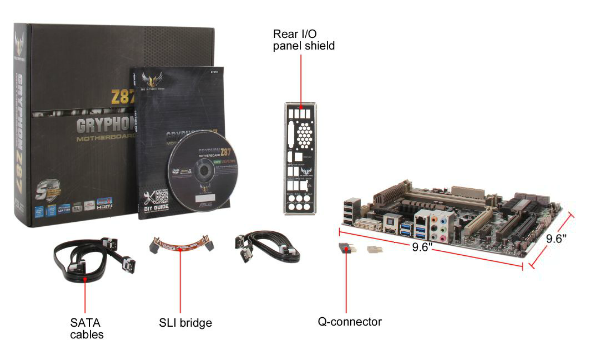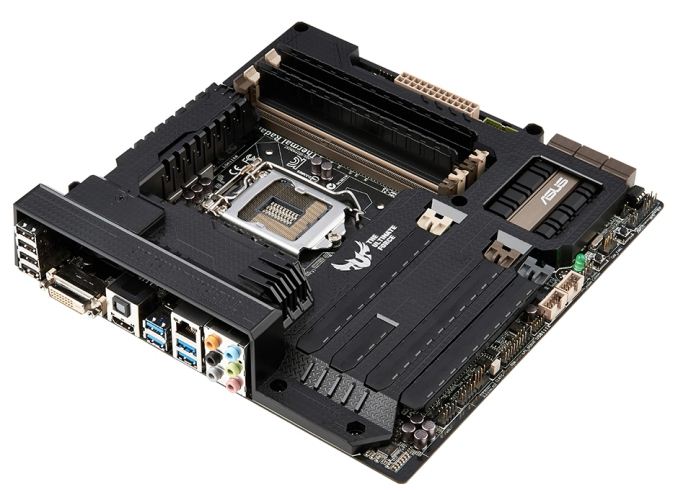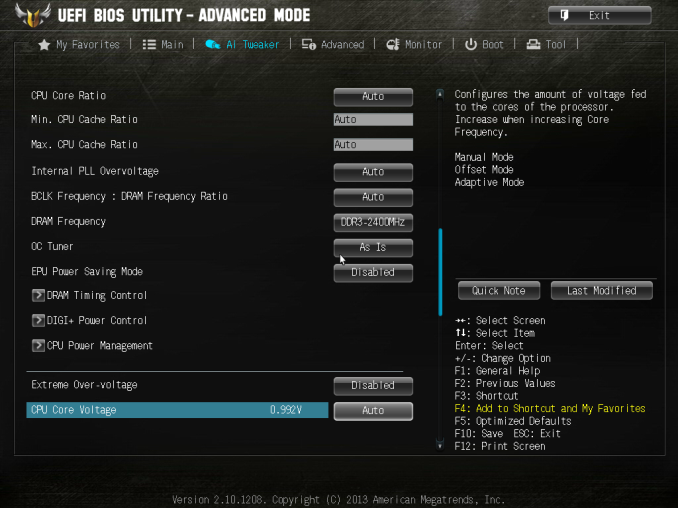ASUS TUF Z87 Gryphon Review
by Ian Cutress on February 3, 2014 10:00 AM EST- Posted in
- Motherboards
- Asus
- Z87
- TUF
ASUS TUF Z87 Gryphon In The Box
Looking back on the original outset of the review, I guess I had no inclination as to what exactly the box of a TUF motherboard would have in it. Given the market for the TUF is towards the longevity and stability of a product, one could argue that safety could be tacked on as well and some form of modified screws with a special screwdriver could be added. Given that the Z87 Gryphon is a ~$162 motherboard, the box contains the following:
Driver DVD
Rear IO Shield
Manuals
Four SATA Cables
Flexi-SLI Bridge
Q-Connectors
Ultimately this is almost the bare minimum ASUS could have put in the box – remove a couple of SATA cables and the SLI bridge would be the minimum compared to what we have seen with lower price segmentation. There is scope here for ASUS to have included something to represent the TUF brand, such as a sticker for a case or a poster. Though I guess what ASUS want users to buy is the Armor Kit, available separately:
ASUS TUF Z87 Gryphon Overclocking
Experience with ASUS TUF Z87 Gryphon
As one might imagine, a motherboard built for stability might not necessarily pull out all the stops to become the best overclocking motherboard on the market. This is probably seen best by the Gryphon’s lack of automatic overclock options – we only found two, and these were further down the overclocking page in the BIOS.
That being said, if ASUS was attempting to escape overclocking, they would have used the H87 chipset. Using some intuition and the manual overclock settings, our CPU still managed to hit the 4.6-4.7 GHz range similar to previous Z87 motherboards we have tested. Motherboards built for longevity and overclocking motherboards are often cut from similar bits of cloth, although the testing applied to either will be different.
Methodology:
Our standard overclocking methodology is as follows. We select the automatic overclock options and test for stability with PovRay and OCCT to simulate high-end workloads. These stability tests aim to catch any immediate causes for memory or CPU errors.
For manual overclocks, based on the information gathered from previous testing, starts off at a nominal voltage and CPU multiplier, and the multiplier is increased until the stability tests are failed. The CPU voltage is increased gradually until the stability tests are passed, and the process repeated until the motherboard reduces the multiplier automatically (due to safety protocol) or the CPU temperature reaches a stupidly high level (100ºC+). Our test bed is not in a case, which should push overclocks higher with fresher (cooler) air.
Automatic Overclock:
The automatic overclock settings are found in the OC Tuner option of AI Tweaker in the BIOS. Selecting this gives two further options to select: Ratio First and BCLK First.
Selecting Ratio First gives a CPU multiplier of 43x/42x/42x/41x, meaning 4.3 GHz in single thread mode down to 4.1 GHz at full load. Over the base CPU turbo, this means an extra 300 MHz on the single thread setting. The BIOS still showed ‘Auto’ for CPU voltages and Load Line Calibrations, and in the OS this gave a load reading of 1.136 volts. PovRay scored 1696.45, and OCCT gave a maximum temperature of 71C. XMP was applied automatically also.
On the BCLK First option, the CPU was adjusted to the 125 MHz strap, giving a 34x125 scenario for all threads, or 4.25 GHz all over. Again the BIOS reported an automatic setting for voltages, although in the OS this meant 1.174 volts during OCCT with a peak temperature of 75C. PovRay scored 1757.7.
Manual Overclock:
For our manual overclock we stayed in the BIOS and started from 4.0 GHz and 1.000 volts. When the system was stable (PovRay + 5 mins OCCT) the multiplier was raised, and for any failure the voltage was raised by +0.025 volts using a fixed voltage application. The following results were achieved:
At 4.7 GHz the system was stable but failing our OCCT temperature tests, giving over 90C. Despite using a TRUE Copper heatsink for this test, better cooling would be needed to push the CPU further.














62 Comments
View All Comments
ReneGQ - Thursday, March 13, 2014 - link
I recently purchased an Asus Motherboard and the problems started from day 1. The drivers update never works, the same for AI Suite III (there´s a lot of updates for this model in Asus webpage). After 2 months I still can´t install BitDefender cause a clock watchdog error.Asus technical support is the worst, mails comes and goes with no solution.
I will not recommend this brand to anyone. The brand has a very good Marketing but the product and the service are very disappointment.
Epimpin - Saturday, November 7, 2015 - link
I literally just had an asus motherboard die on me. It was manufactured in 2003 and has been thru 5 moves, sat outside in the cold wet winter for 8 months and had the ram upgraded like 15 times and went thru 3 CPU upgrades and 3 psu swaps, 5 or 6 RTC batteries, 10 or so bios flashes and countless peripherals installed. The A8N motherboard. I was able to play GTA IV on high settings with an AMD R9 Video Card and an SSD last year. I also have a KFN5-D SLI (Circa 2006) with 2 Opteron 2393 SE Quad Core 3.1ghz Processors in which overclock fine with golden orb 2 heatsinks to 4.0ghz. I plan to have it around for a long time since i had it RMA'd this year with my extended ASUS Server Care package, well worth the $300. This motheboard and proc combo has been stomping every comparable core#/memory/SLi rig for years due to its 8000M/T Controller and FSB. System bus has been matched to processor speed and memory speed across channels giving ZERO bottlenecks. Something that other manufactures have yet to master. Asus is a great company and makes great stuff. I just bought This Z87 and ot it for 46.99 and it came with a 50$ mail in rebate so they paid me to buy it. Today i just bought the TUF Armor kit from Microcenter for 67$ and it has a 30$ mail in rebate so all in all I paid 37.99 for the Asus Gryphon Z87 TUF Armor Edition. Bought an I7 4790 for 239.99, Coolermaster G650M power supply for 64.99 and a 16G kit of 1866 XMP Patriot Viper mem for 42.00 and used my current pair of 120gig Samsung 840's in raid 0 and I have a really sweet system of under 500. Add in 2x AMD R9 295x2's in SLi and this system is going to rip holes in GTA V in Ultra at 4K. So for all of you Ripping on ASUS, You should look at the alternative companies, their products are far inferior to ASUS in manufacturing tech and innovation, ASUS is always CREATING tech that others are doing a piss poor job of emulating. Im my Honest and professional opinion the only other company that is better than or in the same class as ASUS is TYAN and they only make server boards now.